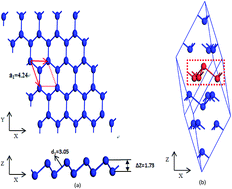Effects of low dimensionality on electronic structure and thermoelectric properties of bismuth
Abstract
First-principles calculations and Boltzmann transport theory have been combined to comparatively investigate the band structure, phonon spectrum, lattice thermal conductivity, electronic transport properties, Seebeck coefficients, and figure of merit of the β-bismuth monolayer and bulk Bi. Calculation reveals that low dimensionality can bring about the semimetal-semiconductor transition, decrease the lattice thermal conductivity, and increase the Seebeck coefficient of Bi. The relaxation time of electrons and holes is calculated according to the deformation potential theory, and is found to be more accurate than those reported in the literature. It is also shown that compared with Bi bulk, the β-bismuth monolayer possesses much lower electrical conductivity and electric thermal conductivity, while its figure of merit seems much bigger. The derived results are in good agreement with experimental results in the literature, and could provide a deep understanding of various properties of the β-bismuth monolayer.



 Please wait while we load your content...
Please wait while we load your content...